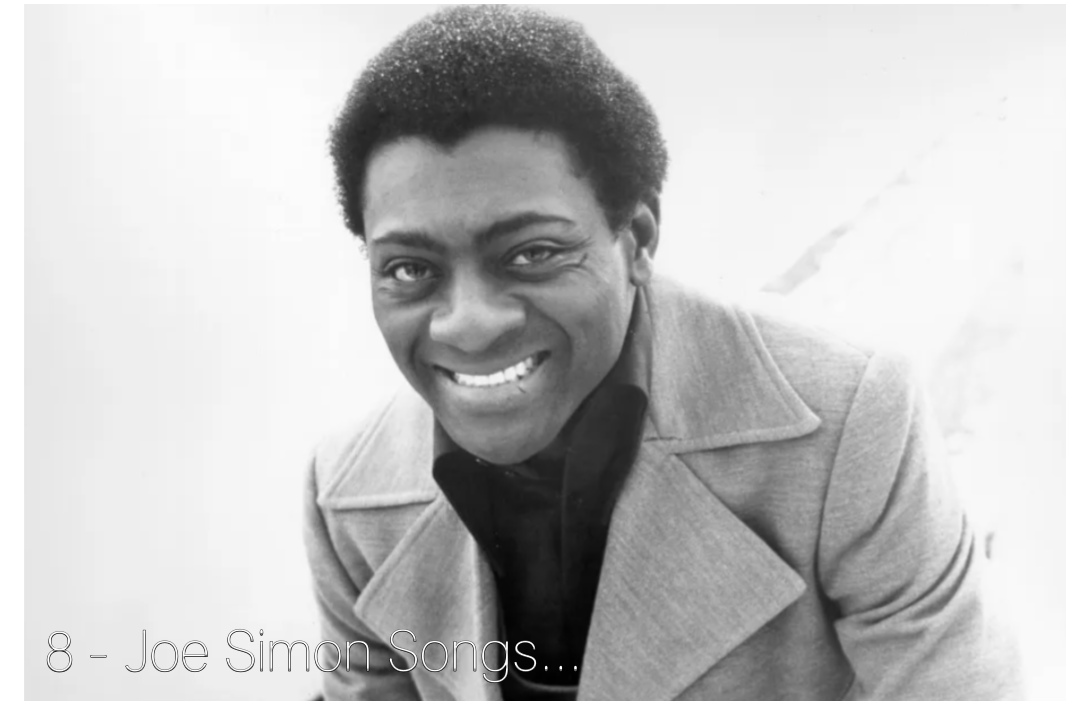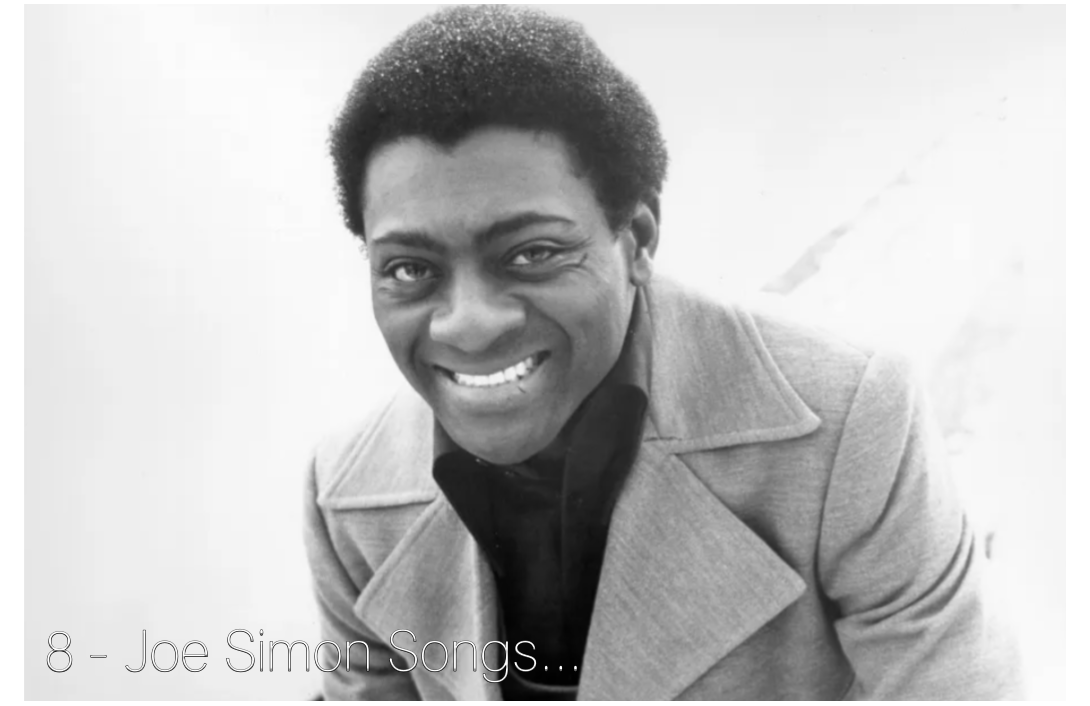-
 play_arrow
play_arrow
Praise 24/7 NO Today's Best Gospel

(ThyBlackMan.com) Joe Simon occupies a unique place in American music history. With a career that spanned gospel beginnings, R&B chart dominance, and seamless forays into funk and disco, Simon proved that great artistry is defined by adaptability and authenticity. Known for his resonant baritone and his ability to make any lyric feel lived-in, he bridged the worlds of Southern soul storytelling and sophisticated urban production. His songs often carried life lessons—about love, perseverance, and self-respect—wrapped in melodies and grooves that continue to connect with listeners decades later.
While Simon’s commercial success was substantial, his enduring influence lies in the emotional honesty of his performances. He could deliver a cautionary ballad with quiet authority, an upbeat groove with unshakable joy, and a cinematic funk track with style and confidence. This versatility ensured that his music has not only aged well but also remains relevant in a modern listening landscape.
The following eight songs represent essential moments in Joe Simon’s catalog. They reveal the depth of his artistry, the range of his vocal interpretations, and the timeless quality of his musical messages. Whether you are a dedicated soul music historian or a new listener seeking to explore beyond the obvious hits, these recordings serve as an ideal starting point to understand why Joe Simon’s work continues to resonate.

1. “The Chokin’ Kind”
“The Chokin’ Kind” wasn’t just another soul single in 1969—it was the record that cemented Joe Simon as a master interpreter of songs outside the typical R&B lane. Coming from a country music pen, Harlan Howard’s lyrics could have easily stayed within Nashville’s storytelling tradition, but Simon took the song, infused it with Southern soul grit, and made it universal. It also earned him a Grammy, further proving his ability to bridge genres in a way few artists of the time could manage.
From a technical standpoint, the track’s genius lies in its sparseness. The rhythm section doesn’t crowd Simon’s voice; the bassline gently anchors the groove, while light percussion and understated horn swells provide just enough drama. The guitar licks are minimal yet perfectly placed, allowing the emotional tension to build naturally. This stripped-down approach makes Simon’s vocal nuances—the slight catch in his throat, the deliberate pauses—feel like part of the instrumentation.
Thematically, “The Chokin’ Kind” was ahead of its time. In an era where romantic ballads often glorified devotion no matter the cost, Simon was warning against love that strangles rather than nurtures. His delivery makes the listener believe he’s lived this story, experienced the suffocation, and come out wiser. In today’s conversations around boundaries, emotional safety, and self-worth, the song’s message rings with startling clarity.
In 2025, its replay value comes from more than nostalgia. It’s a perfect example of how soul music can carry moral lessons without sounding preachy. You can enjoy it for its warm groove, but you might walk away thinking more carefully about the kind of love you let into your life—a hallmark of truly timeless music.
2. “Your Time to Cry”
If “The Chokin’ Kind” was a warning, “Your Time to Cry” was the moment of reckoning. Released just a year later, this track is Joe Simon in full storyteller mode, delivering a breakup narrative with the calm confidence of someone who knows the tables have turned. It also marked another big hit for Simon, showing he could dominate the charts while keeping his storytelling front and center.
The production, driven by John Richbourg, is lush but not overbearing. The organ hums like an emotional undercurrent, the bass throbs in slow, deliberate pulses, and the drums never rush—mirroring the narrator’s calm delivery of a painful truth. The background singers don’t simply harmonize; they act as a kind of Greek chorus, underscoring the inevitability of karma.
What makes Simon’s approach so compelling here is his restraint. He doesn’t gloat, and he doesn’t shout. Instead, he lets the weight of the words do the work. This makes the track all the more cutting—because it feels like it’s delivered from a place of maturity rather than spite. In a way, Simon is giving a masterclass on how to sing about revenge without losing your dignity.
Modern listeners will find “Your Time to Cry” resonates in the same way a sharp, well-written drama does—it’s about human nature, the cycles of relationships, and the reality that time often reveals the truth. Played late at night through headphones, it’s almost therapeutic, letting you process your own moments of vindication with a smooth, soulful soundtrack.
3. “Drowning in the Sea of Love”
By the time “Drowning in the Sea of Love” arrived, Joe Simon was already respected, but this song catapulted him into mainstream recognition. Produced by Kenny Gamble and Leon Huff—the architects of the Philadelphia soul sound—the track was a perfect marriage of Simon’s Southern gospel roots with Philly’s silky, orchestrated arrangements. It shot up the charts, becoming one of his signature hits.
Musically, the song is lush without losing its rhythmic drive. The strings swirl like ocean currents, the horns punch through like bursts of sunlight, and the rhythm section creates a steady undertow that pulls the listener along. Simon rides this wave with effortless authority, stretching his baritone across the melody in a way that feels both grounded and soaring.
The lyrics capture the intoxication of love—its beauty, its depth, and its capacity to overwhelm. Simon doesn’t play it as a tragedy, but there’s a subtle sense of danger in his delivery, as if he knows that too much of a good thing can pull you under. That complexity is what keeps the song from being just another love ballad—it’s romantic and cautionary in equal measure.
Even now, over fifty years later, “Drowning in the Sea of Love” doesn’t sound dated. Its emotional core remains intact, and its production style is so rich that it could easily slot into a modern neo-soul playlist. Artists like Leon Bridges or Raphael Saadiq could cover it today and still find its themes fresh—proof of its staying power.
4. “Power of Love”
“Power of Love” marked a shift in Simon’s tone—less brooding, more celebratory. While his earlier hits often dealt with love’s complexities and dangers, this track leaned into love’s uplifting and transformative side. It became another chart success, showing Simon’s ability to pivot stylistically without losing authenticity.
The track bursts with energy right from the opening horn blasts. Funk-inspired basslines lock in with crisp drumming, while the guitar chops add a rhythmic sharpness. The horn section, full of bright stabs and swells, drives the momentum forward, creating a groove that’s impossible not to move to. Simon’s vocal approach here is more exuberant than restrained—he’s not just telling you about the power of love, he’s embodying it.
Lyrically, it’s straightforward but effective. Simon frames love as a positive force that can change perspectives, heal wounds, and inspire action. The gospel-style background vocals lift the track into something almost spiritual, connecting romantic love to a broader sense of joy and unity.
Today, “Power of Love” works beautifully as a mood-booster. Drop it into a party playlist, and it blends seamlessly with modern funk and soul revival tracks. Play it on a morning commute, and it becomes an instant energy shot. It’s a reminder that Joe Simon wasn’t just the master of the cautionary ballad—he could also deliver pure, feel-good soul without losing depth.
5. “Step by Step”
“Step by Step” is one of Joe Simon’s most uplifting tracks—an anthem for perseverance, faith, and determination. Released the same year as “Power of Love,” it shows Simon taking his natural storytelling ability and applying it to a motivational context. Rather than focusing on romantic love or heartbreak, here he offers a life lesson: progress is best made in small, consistent steps.
The opening guitar riff is crisp and deliberate, setting a tone of confidence before the tight rhythm section locks in. The groove has a bounce to it, carried by a warm bassline and subtle hi-hat work that keeps the song moving without ever feeling rushed. Horn accents punctuate the verses like exclamation points to Simon’s statements, while the backing vocalists respond to his lines in a call-and-response style that reinforces the sense of community and encouragement.
Lyrically, “Step by Step” could be mistaken for a self-help seminar soundtrack—but it avoids the hollow platitudes often found in motivational music. Simon sings like someone who has lived the struggle, which gives his encouragement real weight. You believe him when he says success doesn’t happen overnight. His warm yet authoritative baritone makes him sound less like a preacher lecturing from a pulpit and more like an older friend or mentor who’s been down the road before you.
In today’s fast-paced, instant-gratification world, “Step by Step” feels even more relevant. It’s a soulful reminder that steady, incremental progress often outlasts quick wins. Whether you’re chasing a career goal, rebuilding after a personal setback, or simply trying to form better habits, this song still speaks directly to the heart—and the beat ensures your feet will be moving while your spirit soaks in the message.
6. “Theme from Cleopatra Jones”
When Joe Simon stepped into the world of blaxploitation soundtracks with “Theme from Cleopatra Jones,” he tapped into a cultural movement that celebrated Black style, power, and independence on the big screen. The 1973 film, starring Tamara Dobson, was an action-packed statement of empowerment—and Simon’s theme song perfectly encapsulated that spirit.
From the opening horn blast, the track announces itself with confidence and flair. The bass line struts forward with a sense of purpose, while the drums hit with cinematic precision, giving the song a larger-than-life feel. The orchestration is lush, combining strings and horns in a way that mirrors the sophistication and style of the film’s heroine. At the same time, a deep funk groove keeps the track grounded in the earthy, street-smart world of ’70s soul.
Simon’s vocals are both commanding and seductive, a mix that mirrors Cleopatra Jones herself. He delivers his lines with admiration and playful swagger, making the song feel like both a tribute and a celebration. The way he draws out certain words adds a sensual undercurrent, reminding listeners that empowerment can be as stylish as it is strong.
Even for listeners who have never seen the film, “Theme from Cleopatra Jones” works as a stand-alone funk-soul gem. It’s cinematic but not overly theatrical, funky but not one-dimensional. In 2025, it still stands out as one of the better examples of a soundtrack cut that transcended its original context. DJs could drop this into a funk set today and watch it work the dance floor, proving that great grooves and confident storytelling never go out of fashion.
Finish story here; 8 Joe Simon Songs That Showcase His Soul Music Greatness.
Written by: Black Gospel Radio
Similar posts
-

D.K. Smith
For every Show page the timetable is auomatically generated from the schedule, and you can set automatic carousels of Podcasts, Articles and Charts by simply choosing a category. Curabitur id lacus felis. Sed justo mauris, auctor eget tellus nec, pellentesque varius mauris. Sed eu congue nulla, et tincidunt justo. Aliquam semper faucibus odio id varius. Suspendisse varius laoreet sodales.
close Top popular

The Science of Happiness – Exploring Factors for Well-Being

Balancing Act: Prioritizing Your Well-Being in a Busy World

Overcoming Procrastination – Strategies for Productivity and Success

Unlocking Hidden Potential – A Guide to Personal Growth

Mindful Living – Cultivating Presence in the Modern Era

CONTACT US
- info@praise247no.com
FOLLOW US
- Praise247NO
- Praise247NO
- Praise247NO
Copyright 2024 Praise247no.com - All Rights Reserved.




Post comments (0)